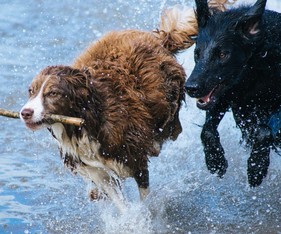
Over the summer there has been increasing media coverage on harmful algal blooms (HABs).
HABs form when cyanobacteria, also known as blue-green algae, which are a natural part of water bodies, produce toxins, called cyanotoxins, that can make animals and people sick. When conditions are right, these organisms can increase rapidly to form cyanobacterial blooms—or harmful
algal blooms.
Harmful algal blooms generally occur during the hottest part of the summer, but have been seen at any point between May and October, depending on weather conditions.
Animals, especially dogs, typically get ill from HABs when they ingest water from toxin-containing water bodies. Animals may also ingest affected water when swimming. Symptoms can develop very quickly and may include lethargy, vomiting, diarrhea, drooling and seizures. This is an urgent situation, as death of the animal can occur rapidly depending on how much toxin is consumed.
The Animal Industry Division has created two new resources to help you and your clients better understand HABs:
Harmful Algal Blooms for Animal Owners
Harmful Algal Blooms for Veterinarians
More information on HABs can be found on the Michigan Department of Environment, Great Lakes, and Energy's website at www.michigan.gov/habs.
|